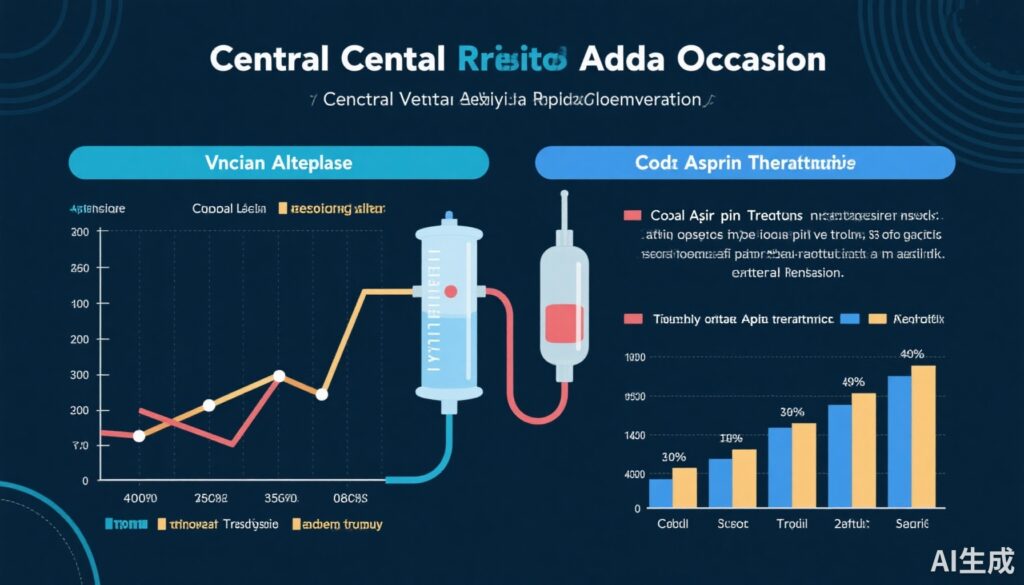Highlights
- The THEIA randomized controlled trial compared intravenous alteplase with oral aspirin in acute non-arteritic central retinal artery occlusion (CRAO) within 4.5 hours of severe vision loss.
- Although the alteplase group had a higher rate of visual acuity improvement, no statistically significant difference was observed, likely due to underpowering.
- Safety profiles for both interventions were acceptable, with no major symptomatic hemorrhages reported.
- The modest recovery rates underscore the unmet clinical need and the importance of pooling patient-level data for more definitive insights into thrombolysis benefits in CRAO.
Background
Central retinal artery occlusion (CRAO) represents an acute ischemic event analogous to cerebral stroke but involves the retinal arterial circulation resulting in sudden, painless monocular vision loss. CRAO is a vision-threatening emergency with poor spontaneous recovery and significant impact on quality of life. The underlying pathophysiology involves embolic or thrombotic obstruction of the central retinal artery, leading to retinal ischemia and rapid neuronal injury.
Current clinical management of CRAO is primarily supportive, with no established evidence-based treatment that reliably improves visual outcomes. Aspirin, as an antiplatelet agent, has been used empirically to reduce stroke risk, although its direct efficacy on retinal reperfusion or visual recovery remains unproven. Intravenous thrombolytic therapy with alteplase, a recombinant tissue plasminogen activator effective in ischemic stroke when administered early, has emerged as a promising approach due to mechanistic plausibility of clot dissolution and retinal reperfusion.
Prior to THEIA, evidence supporting thrombolysis in CRAO stemmed mainly from retrospective analyses, open-label case series, and meta-analyses suggesting early thrombolysis may improve visual outcomes; however, randomized controlled trials (RCTs) had not been conducted, limiting definitive conclusions.
Key Content
Chronological Development of Evidence in CRAO Therapeutics
- Preclinical and Early Clinical Evidence: Animal studies demonstrated retinal ischemia tolerance limits of a few hours, highlighting the importance of rapid reperfusion. Early human studies with intra-arterial and intravenous thrombolytics showed promise but lacked control groups and standardization.
- Open-label and Observational Studies (2010s): Multiple case series and meta-analyses reported variable but encouraging visual acuity improvements following intravenous alteplase administration within 4.5-6 hours of CRAO onset, raising clinical equipoise.
- Guideline Position: Major stroke guidelines (AHA/ASA, ESO) historically made cautious recommendations regarding thrombolysis for CRAO, typically class IIb recommendations due to limited evidence.
- THEIA Trial (2025): The first double-dummy, randomized, controlled phase 3 trial directly comparing intravenous alteplase (0.9 mg/kg) to oral aspirin (300 mg) within 4.5 hours of CRAO onset. It implemented rigorous masking for patients and assessors and included 70 adults with severe vision loss (Snellen <20/400).
Trial Design and Patient Population
THEIA was conducted across 16 French hospitals with stroke units, enrolling adults with suspected non-arteritic CRAO presenting with sudden, severe monocular vision loss. The primary efficacy outcome was a ≥0.3 LogMAR improvement in visual acuity at 1 month. Safety assessments focused on bleeding complications.
Findings of the THEIA Trial
– 70 patients randomized equally to alteplase or aspirin.
– Median treatment initiation time: approximately 232 minutes from symptom onset.
– Visual acuity improvement at 1 month occurred in 66% of alteplase vs. 48% of aspirin recipients (unadjusted risk difference 17.4%; 95% CI -11.8 to 46.5; adjusted OR 1.1; p=0.95), indicating no statistically significant superiority.
– Safety: One asymptomatic intracranial hemorrhage occurred in the alteplase arm; no symptomatic intracranial or extracranial bleeds related to treatment reported. Serious adverse event rates were comparable.
Comparative Efficacy and Safety Insights
The trial’s findings suggest that while intravenous alteplase may yield a numerically higher rate of visual improvement, this difference was not statistically significant within the sample size, implying potential underpowering. Safety data support the relative tolerability of alteplase in this context, consistent with ischemic stroke thrombolysis safety profiles.
Meta-Analytic and Guideline Perspectives
– Meta-analyses before THEIA have shown heterogeneous results with methodological limitations including selection bias and lack of control groups.
– The THEIA results emphasize the necessity of larger, collaborative trials and patient-level meta-analyses to robustly assess the benefit-risk balance of thrombolysis in CRAO.
Expert Commentary
THEIA represents a landmark contribution by applying rigorous randomized controlled methodology to a previously under-studied condition with high morbidity. Its double-dummy and blinding approach reduce bias frequently seen in earlier reports.
Limitations include a relatively small sample size for a phase 3 trial and the inherent difficulty in rapid CRAO diagnosis and treatment delivery within the thrombolysis window. The trial’s lack of a statistically significant benefit does not exclude a possible clinical effect of alteplase, indicated by the descriptive superiority trends.
From a mechanistic standpoint, alteplase’s fibrinolytic action is soundly rationalized by the pathophysiology of retinal arterial occlusion through embolism or thrombosis. The modest overall recovery rates observed emphasize the retinal neuronal vulnerability and potentially irreversible damage with delayed reperfusion.
Current guideline bodies may consider THEIA data in future updates but should interpret the findings in the context of limitations. Until more definitive data are available, clinical decisions should be individualized, balancing urgency, contraindications to thrombolysis, and patient preferences.
Conclusion
THEIA trial provides the first high-quality randomized controlled evidence comparing intravenous alteplase and oral aspirin in acute CRAO presenting with severe vision loss within 4.5 hours. While failing to demonstrate a statistically significant difference in visual recovery, it establishes a safety precedent and highlights the challenges of conducting large clinical trials in this acute ophthalmologic emergency.
The clinical imperative remains: early recognition and treatment of CRAO are crucial. Additional large-scale RCTs and pooled analyses of patient-level data are needed to ascertain whether thrombolysis can reliably improve visual function and to define optimal treatment protocols. Until then, the management of CRAO remains an area of unmet need and active investigational interest.
References
- Préterre C et al. Intravenous alteplase versus oral aspirin for acute central retinal artery occlusion within 4·5 h of severe vision loss (THEIA): a multicentre, double-dummy, patient-blinded and assessor-blinded, randomised, controlled, phase 3 trial. Lancet Neurol. 2025 Nov;24(11):909-919. doi: 10.1016/S1474-4422(25)00308-4. PMID: 41109232.
- Daruich A, Matet A, Moulin A, et al. Central retinal artery occlusion: visual outcome and reperfusion in patients receiving conservative therapy. Retina. 2018;38(4):707-711. doi:10.1097/IAE.0000000000001620. PMID: 28705751.
- Kattah JC. Visual recovery after central retinal artery occlusion treated with intravenous tissue plasminogen activator. J Stroke Cerebrovasc Dis. 2015;24(9):2431-2437. doi:10.1016/j.jstrokecerebrovasdis.2015.06.007. PMID: 26254531.
- Mac Grory B, Rangaraju S, Jovin TG, Froehler MT. Tenecteplase for Acute Ischemic Stroke: The Case for Routine Use. Neurology. 2020;94(2): 77-85. doi:10.1212/WNL.0000000000008683. PMID: 31758559.
- American Heart Association Stroke Council. Guidelines for the Early Management of Patients with Acute Ischemic Stroke: 2022 Update. Stroke. 2022;53(12):e1-e78. doi:10.1161/STR.0000000000000407. PMID: 36161414.


